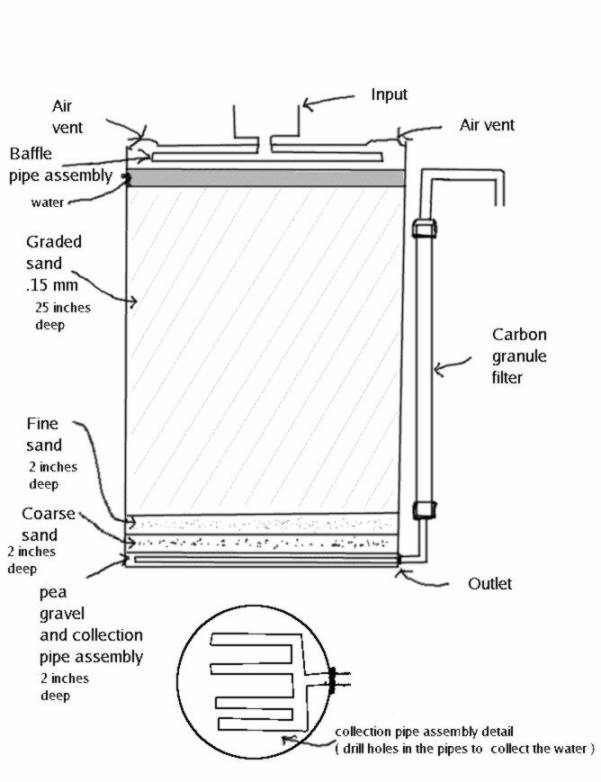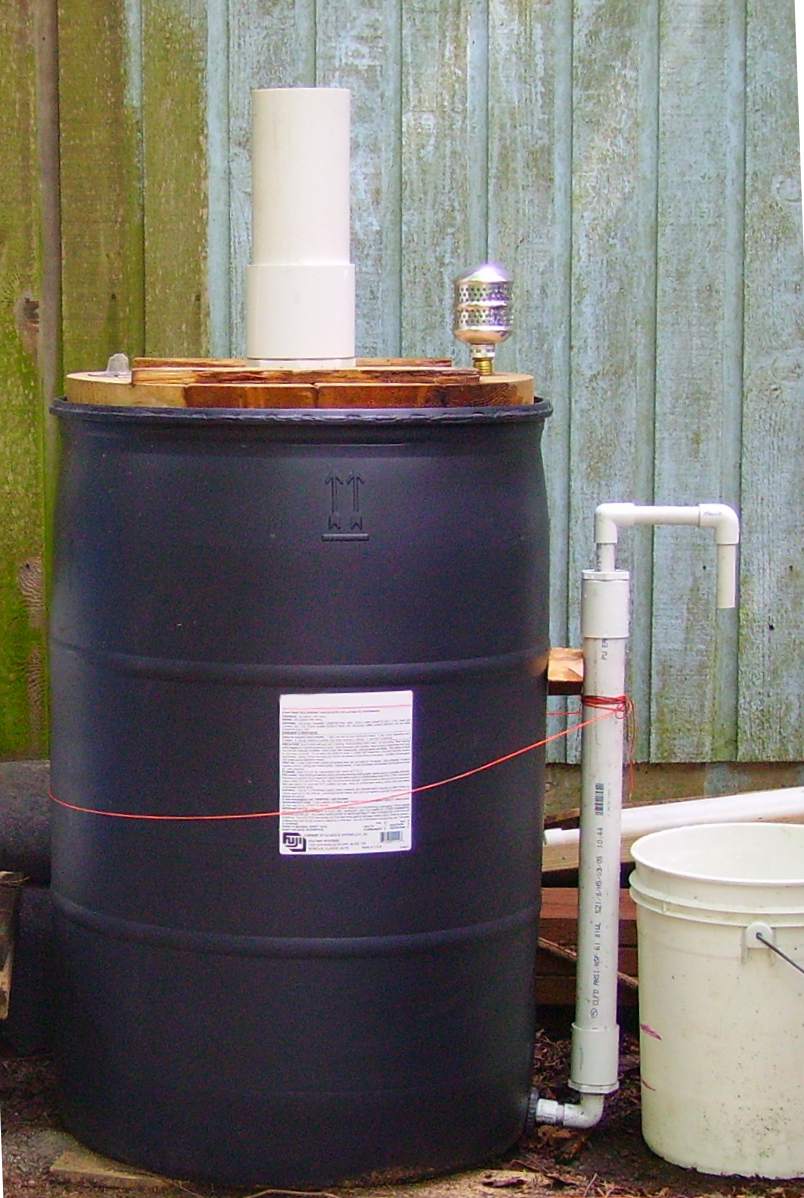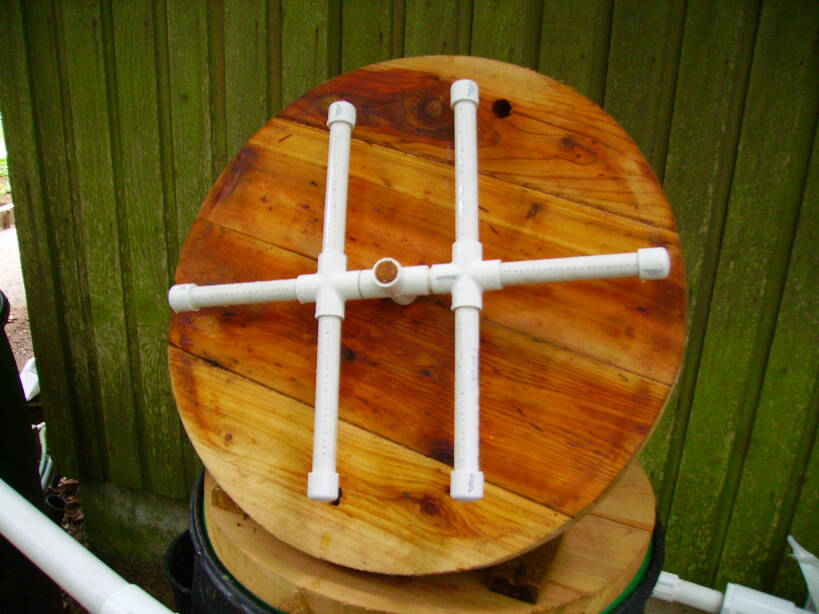Comment filtrer l’eau avec un filtre à sable
Soutenez le travail d’Howtopedia, aidez-nous à continuer à écrire et à traduire plus d'articles pratiques sur des technologies simples!
<paypal />
Sommaire
Short Description
- Problem: Filtering water
- Idea: Using the filtering properties of sand
- Difficulty: Understanding the principle of the schmutzdecke. Using the filter properly (first use, continuous filtering, regular replacement of the sand)
- Price Range: Cheap
- Material Needed: A big container (best are non reactive surfaces: plastic, concrete tanks... from 200 liters up), different sand sizes, reservoir and pipes for the dirty water and for the clean water, a tap
- Geographic Area: Global
- Competencies: Simple plumber skills
- How Many people? From one person on
- How Long does it take? 1 to 4 days to build the filter, depending on its complexity, 10 days before water should be drunk.
Description
Slow Gravity Sand Filters
Safe drinking water can be reached with this type of sand filters. Thanks to mechanical and biological action in the sand layer, slow gravity sand filters remove bacteria as well as small particles from water, making it safe to drink. This is a basic introduction to the subject and should help maintain a constant supply of clean, running water using simple technology. The sand filter described below is designed for domestic use only.
Water source
It is important to have a relatively clean source of water, that means free from chemicals and heavy metals, because a Sand Filter won't provide a sufficient filtering to turn chemically polluted water into drinkable water. It is important to test a sample of water in a laboratory before you start. Even spring water or very clear river water should be tested for chemical contaminants. If your water source has a high level of contamination, try to locate a new one. If this isn't possible other methods of filtration should be used. If the water is very brown, that is has a high turbidity level, it should be treated before it gets to the sand filter. For example stay in settling tank or pass through a horizontal roughing filter before it goes in the proper sand filter.
How the filter works
The water passes through the sand from top to bottom. Larger suspended particles will settle in the top layers of sand. Smaller particles of organic sediment left in the sand filter are eaten by microscopic organisms including bacteria and protozoans which 'stick' in the layers of slime that form around the sand particles. The clean water which passes through the filter is safe to drink. If the grain size is around 0.1mm in diameter, a sand filter can remove all fecal coliforms (bacteria that originate from feces) and virtually all viruses.
Slow Sand Filters
The drawing shows a typical sand filter. The dirty water should flow into the upper part of the tank without disturbing the schmutzdecke (a layer of slime that forms on the top of the sand after a few days and contains beneficial bacterias). There should be a sufficient depth of water above the sand so that enough pressure pushes the dirty water through the schmutzdecke, the filter bed, and into the support gravel. This depth should ideally be about 2-3 meters (7-10 feet) even if 1.5 meters (4 feet) should also allow the filter to work properly. This depth will depend on the sand properties and the porosity of the schmutzdecke. The maximum water level may be controlled by using a float and a control valve or by maintaining the water lever near the overflow line. Important: the filtration should be continuous, the sand should always be submerged and the schmutzdecke protected from direct sun and strong temperature differences.
The depth of sand (the filter bed) has a strong influence on the effectiveness of the filtration and should be at least (minimum) 75 cm / 1 meter (30" - 40").
Sand properties are defined with the grain diameter and the properties ES (Effective Size) and UC (Uniformity Coefficient). For the Slow Sand Filter, sand needs to be very fine (0,1 to 0,35mm diameter) ES typically is 12 to 40 mm (0.5" to about 1.6") and UC should be less than about 2.5.
Typical water processing rates in slow sand filters are about 2.5 m3/[m2 of filter cross-section area - day] = about 0.1 m/hour (0.33 ft/hour). The filtration rate may be determined by a flow meter on the outlet tap. Unless the raw water is particularly well treated to about 20 turbidity units or less, this figure should be maintained, unless a very reliable post-ssf disinfection is in place. High turbidity (lots of particles in the water) of the raw water will block the sand filter quicker, shortening the time between cleanings and lowering the water quality. It might also shorten the filter life extremely from several months to some days. The raw water should be pre-treated, for example with a Horizontal Roughing Filter that helps reduce the turbidity from an average of about 200 units, with occasional short-term peaks to around 1000, down to about 20. Turbidity reduction can also occur thanks holding ponds or sedimentation tanks with a floating water intake. The schmutzdecke is a layer where bacteriological and physical processes occur, the main one being that most of the suspended matter is being pressed in a thin dense layer in which the pores may be less than a micron. The thickness of this layer increases with time until the flow rates become very small,at this point, it is usually about 25 mm (1"). That is the time where a layer of the filter has to be taken away.
Bacteria and viruses are traped in the schmutzdecke. Bacterial and biological activity maximizes in the schmutzdecke but will continue up to 20 cm deep in the sand of the filter bed. A certain minimum level of dissolved oxygen should be present to support the aerobic actions that occur in the bed. After the initial installation of the Sand Filter, the formation of the schmutzdecke and bacterial/biological activity will take some days or weeks depending on the ambient temperature. During this period the processed water is unsafe for human consumption and should not be drunk, or must be filtered in another filter, or disinfected with other means. Water quality tests should be done at a regular intervals until the required standard is reached.
Cleaning the filter
When clean water flow becomes very small, the sand filter must be cleaned. Remove very carefully about 25 mm (1") of the top layer, which includes most of the existing schmutzdecke, with broad flat-bottomed shovels after dropping the water level to slightly below the latter. In strong hot sunlight this should be done as quickly as possible to avoid drying out and damage to the biological matter in the top layer, which will be the base of the new schmutzdecke. When the filter is restarted, the processed water must again not be consumed until the required level of quality is again reached. This takes several days.
When the depth of the bed of sand will have been reduced by the cleaning processes to about 0.75 meters (30"), the original depth must restored by adding new sand. because the new sand will have no biological activity, the process is accelerated by removing and discarding the schmutzdecke, and then the top 20 centimeters of the existing bed is removed and kept to be re-use on top of the new sand. this help to restore quickly the biological activity and new schmutzdecke. The sand from the existing bed should not be allowed to dry out and should be set in place again as quickly as possible.
Difficulties
- When used for a large amount of water, the Slow Sand Filter needs large amounts of land, because of the low filtering rates ( 10 per cent of the filtering rates allowed by rapid filtration).
- Because of the slow rates, the clean water has to be stored in proper containers (clean and protected from light to avoid Algae proliferation and from dust) to adapt the peak demand.
- Great care in the operation and maintenance, in particular in relation to the schmutzdecke which requires some time to form. The processed water cannot be considered safe until it has and the water that is passed through the system while the schmutzdecke is forming must be cycled back or discarded.
- While first building the filter,in order to avoid the formation of air pockets in the sand bed, the sand should be either dropped in the tank filled up with water or be filled with water from the bottom.
- In regions with high arsenic concentration in the ground water, special measures apply! the incoming water should be oxigenated (cascade or sprinkler principle) when poured in the filter, and regulary completely drained out of the filter container to stop bacterial activity! for a better arsenic removal, the additition of a top bed of iron nails might be necessary, especially if the water has a low iron concentration.
See: http://www.arsenic.eawag.ch
Ngai, T.; Walewijk, S. (2003) The Arsenic Biosand Filter (ABF) project: design of an appropriate household drinking water filter for rural Nepal. Final Report. Massachusetts Institute of Technology and Stanford University, USA.
Success Story
We have built one of these biological layer sand filters from mostly recycled material, run it for 3 weeks and had the water tested. (The website link below in the "links" section has the details of the tests and more; and the "plans illustrations and posters" sections has some pictures) The filter removed 100 percent of the E.Coli, Coliform and Fecal Coliform bacteria from the water. These filters work. And they work well. This system produces no left over plastic bottles, and for the price you would pay for four or five cases of "top quality" bottled water, you can probably build this entire filter. If you buy bottled water year round you could easily pay for the battery, pump, storage barrels and filter for less than it would cost you for the bottled water. Then all your water is free. But you don't even need the pump or battery. If you are living in one of the many areas in the U.S. that are now experiencing 50 or 100 year droughts you may want to consider this seriously . . . build it and have it ready for the first rain, and you will have all the water you need to drink, or water your flowers or wash your car . . . what ever - it's your water. Just remember that the water must be circulated through the filter for at least 3 weeks before it is safe to drink. And, any chemicals you have put on your roof will be in the water you collect. (those chemicals will eventually end up in water anyway because they flow off your roof into the ground and eventually back into a river or aquifer.) An 1800 square foot roof will collect over 2200 gallons of water with 2 inches of rainfall. If you have 6 downspouts equally spaced that means each one will deliver over 300 gallons of water. You don't need a college degree to be smart enough to figure out how to be careful and how to operate one of these filters. The basic operation is simple. The God given ecosphere of this earth cleans water for us with natural processes that work in these filters much in much the same way our rapidly disappearing wetlands clean water for us. The biofilm that grows on the sand forms a living barrier that destroys most bacteria and only allows water to pass through it. These filters (much larger of course) are used in Europe extensively for public water supplies.
Caution: know exactly what is in the sand used in the filter. Sand can contain many different kinds of contaminants, some very hazardous.
Plans, Illustrations, Posters

This is a drawing of the filter

This is a picture of the outside details

This is a picture of the baffle pipes that keep the incoming water from disturbing the biolayer on top of the sand inside.

Detail of the baffle pipes

The added convenience of a recirculation system.
Contacts
Links
- "Success story" link to the website describing the filter in detail:http://www.shared-source-initiative.com/biosand_filter/biosand.html
- Harvesting rainwater and BioSand filters:http://www.rainwaterconnection.com
- Brief description and drawing of a BioSand filter:http://www.unc.edu/sobseylab/res.html
- Filters are used in many parts of the world:http://www.villagehealthproject.org/6.html
- Drawings and explanations:http://www.chrisrolling.com/cwfh.htm
- Manufacturer of filters:http://www.watertiger.net
- Nice explanation and drawing in English and other languages:http://www.jalmandir.com/filtration/biosand/biosand-filters.html
- Very detailed explanations are here at this site:http://www.biosandfilter.org/biosandfilter/
- Commercial site and one of the first developers of the BioSand filter:http://www.abheritage.ca/abinvents/inventions/inv_hw_biosand_water_filter.htm
- Pictures and explanations here:http://homepage.ntlworld.com/c.wrightson/bio_sand_filter.htm
- this link has information about the size of sand grains: (.15 - .35 mm):http://www.oasisdesign.net/water/treatment/slowsandfilter.htm
- Good explanation of filters from this site in Canada:http://www.agr.gc.ca/pfra/water/slowsnd_e.htm
- http://www.watertechonline.com/article.asp?IndexID=5210904
- http://www.waterinfo.com/ssf.htm
- Procedure for measuring turbidity: http://www.photometer.com/en/abc/abc_095.htm
Bibliography
The Davnor BioSand Water Filter
Manual of Design for Slow Sand Filtration
Slow Sand Filtration, Huisman L. and Wood, W.E., WHO 1974
"Houshold Sand Filter for Arsenic Removal, an option to mitigate arsenic from iron-rich groundwater"
Techical report, EAWAG, S.Luzi, M.Berg, P.T.K.Trang, P.H.Viet, R.Schertenleib, Hanoi, 2004
www.arsenic.eawag.ch
Ngai, T.; Walewijk, S. (2003) "The Arsenic Biosand Filter (ABF) project: design of an appropriate household drinking water filter for rural Nepal. Final Report." Massachusetts Institute of Technology and Stanford University, USA.
Related articles
- turbidity
- How to Lower Water Turbidity with a Roughing Filter,
- How to Pasteurize Water with a Plastic Bottle
- How to Build an Underground Brick Dome Water Tank
- How to Build a Rainwater Tank: Sri Lankan Pumpkin Tank
- How to Harvest Rainwater
- How to Harvest Water
- How to Stock Water in Cement Water Jars
- How to Harvest Rainwater
- How to Harvest Run Off Rainwater
Support the work of howtopedia, help us to continue to write and translate more practical articles on simple technologies!
<paypal />
Catégories
- Community
- Construction
- Crisis Management
- Education
- Equipment Design
- Health
- Hygiene
- Ideas
- Pollution
- Prevention
- Products
- Recycling
- Resource Management
- Sanitation
- Small Business
- Run-Off
- Water
- Water harvesting
- Water purification
- Easy to Medium
- Global Technology
- Arid Climate
- Forest Environment
- Global
- Mediterranean Climate
- Monsoon Climate
- Montaneous Environment
- Coastal Area
- Lakes and Rivers
- Rural Environment
- Temperate Climate
- Tropical Climate
- Urban Environment
- Plastic container
- Sand
- One Person and more
- Household
- Village
- Neighbourhood
- Application
- Practical Action Spanish
- Requested translation to French
- Requested translation to Arabic
- Requested translation to Bangla
- Requested translation to Javanese
- Requested translation to Madarin
- Requested translation to Russian
- Requested translation to Swahili
- Requested translation to Tamil